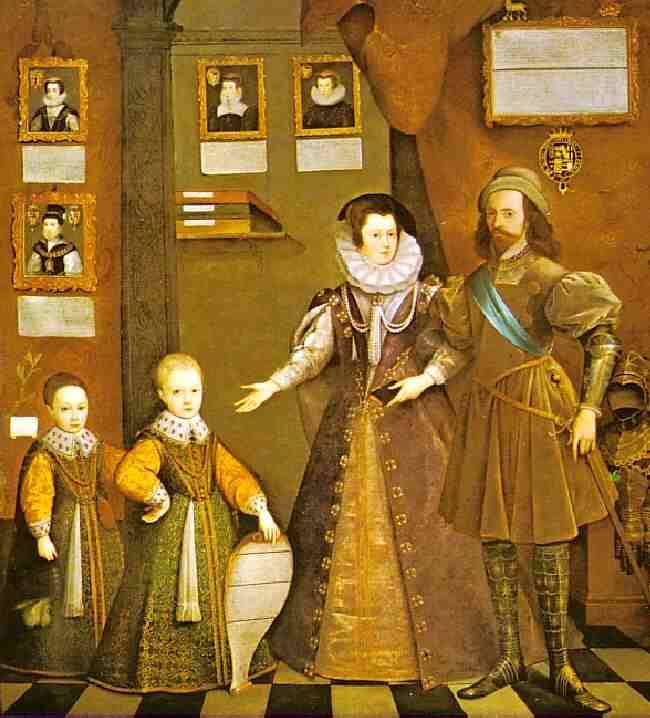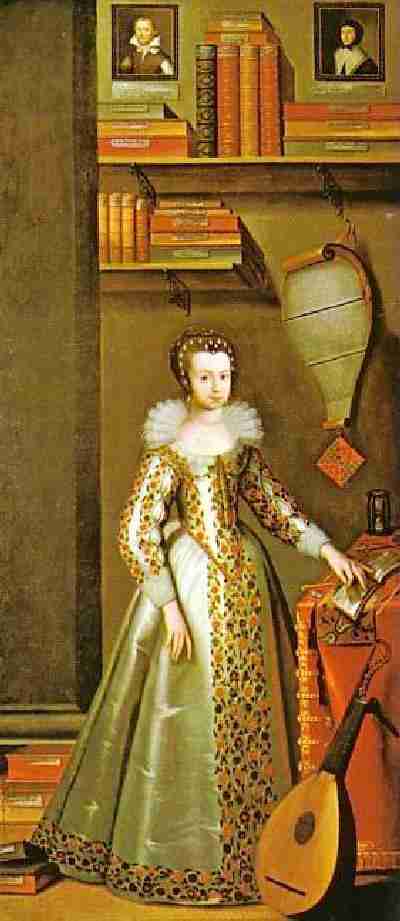
Unknown English Artist Illustrating Boys' Fashions (late 16 th century)

Figure 1.--Here is George Cliffoed Earl of Cumberland and his wife and two sons. His daughter Anne is seen below in a panel of the same painting. The center pannel here probably represents the late 1580s, probably about 1588. It was painted years later in 1646. Notice how the boys, not yet breached, are dressed identically. I have no idea what the older boy is holding, but it appears on the wall in the left pannel shown below.
|
Here we have a fascinating portrait of Anne Clifford and her family, including her two brothers. The fashions represented are thiose of the late Tudor and Stuart eras. We do not know who the artist was, but the central panel of the portrait represents the 1580s. The portrait was painted years later in 1646. Thus the central panel was painted years after the time period represented. This is important in assessing the acuaracy of the clothing depicted. A HBC reader has provided a good bit of information about the boys' sister Anne Clifford. The portrait is currently displayed in London's Tate Museum.
The Great Painting
This portrait known as the 'Great Picture' by a unknown artist (most probably a Flemish born copyist active in England at this time). The painting is now owned by Abbot Hall, Kendal, Cumbria. We believe it is still on loan to the Tate in London where it can be viewed. The portrait was painted in 1646. It was painted in three panels, each which appear to represent three different time periods. The central panel shows her two brothers and her parents. Anne is shown on either side. First as a 15 year old girl and then has an adult woman. These panels are meant to represent the late 1580s (figure 1). The portrait was painted several decades after the actual depiction, we are unsure about the accuracy of the clothing depicted. The left panel shows Anne when she is 15 year old. The left panel represents the year 1605 and that Ann is the surviving daughter because we believe by then that both her brothers had died. (figure 2). The right panel shows Anne as an adult and presumably was painted with the other two panels in 1646.
Clifford Family
The portrait here provides us a fascinating glimse at an arristocratic English family--the Clifords. Anne Clifford was born at Skipton Castle in 1590. She had two brothers, the boys in the painting here (figure 1). The two boys are Sir Robert Clifford and Francis Lord Clifford. Francis was born at Skipton Castle and died there when he was 5 in 1589. This was a few months before Anne was born. Had he lived he would have been 6 years older than his sister. His tomb is in Skipton Parish Church. Her other brother also died very young but we are not sure when. The adults with the boys are Anne’s father and mother. The artist does not reveal what year the painting of the family was meant to represent, but it would be the 1580s.
Clothing
The Clifford boys here wear dresses, styled similarly to their mother's dress. This portrait suggests that the convention of young boys wearing dresses was an established fashion in the 16th century. We are not sure, however, precisely when this convention began. The Clifford's of course were a noble family. This does not necessarily reflect how the middle class or common people dressed. Here images are less available. Poor people couldn't aford portraits and artists of the day were not inclined to paint their portraits.
Anne (1590-1676)
Parents
Lady Margaret Russell, Countess of Cumberland was Anne’s mother. Her father was George Clifford, Earl of Cumberland.
Childhood
Anne was born at Skipton Castle, on the January 30, 1590. This is why she was not pictured in the central pannel of the portrait, she was not yet born. Christened on February 22 when Lady Derby and Lady Warwick were her godparents. Six weeks later she was taken away to live elsewhere and never returned to Skipton for 50 years. Owing to her father's many absences abroad, she was brought up by her mother.
Education
Anne was educated at home by a tutor called Samuel Daniel. Her books were of a serious nature, mostly classical, religious, and included Chaucer, Spenser, Her father would not have her learn anything but English. She developed an interest in science and alchemy. This was an interest she had throughout her life. She was very interested in alchemy. This interest led her to discover many herbal medicines.
Court
Anne at the age of 12 was welcomed to court by Queen Elizabeth, but thge queen was very old by the time she arrived. She was brought to see the Quuen laying in State. She was there when the new King, James I, was proclaimed (1603). Anne first saw King
James at Theobalds. Anne noted in her dairy that "He used Mother very graciously”.

Figure 2.--This is Anne as a girl. I'm not sure what years this would represent. The portrait is done in three pannels. This is the left pannel. The right pannel was done many years later. I'm not sure if this pannel represents the sa,me year as the center pannel above. The right pannel shows anne as an elderly woman, probaby in the 1670s which was probably when the portraits were painted.
|
Diary
Anne is best known for her diary. She kept a diary throughout her life. It records visits to many great houses and the social events she was invited to. It also mentions the many important people she met. Her diary contains much about her grandchildren, especially the Earl of Thanet who came with his bride to visit her at Appleby, in 1664.
Her inheritance
Under British law at the time the eldest brother inherited the tilles and builk of the family property. Both of Anne's brithers, however, died young and the family lands were theoretically her inheritance. There were, however, problems because she was a woman this presented legal difficulties. We think that this may be the reason why, from the age of 14 and for a good part of her life, she was involved in legal battles to retain her inheritance in her own right. There were also problems because of the Civil War and her royalist sumpsthies. Later she had legal battles to obtain the rent money owned her by her tenants.
First marriage
When Anne turned 16 marriage was the question. There were several suitors. It was 1609 when it was decided that Richard, Sackville was to be her husband. At first he was genuinely fond of his wife, but her legal fights to retain her property put a strain on their elationship.
Children
Her first child was Margaret born 1614. Isabella was another surviving daughter. Anne had other children but they died in infancy. She was very fond of Margaret and Isabella. Isabella married the Earl of Northampton in 1647.
Widow
In 1624 her husband died. She was a widow for 6 years before she married again.
Second marriage
Anne in 1630 married the Earl of Pembroke, He had by his first wife 10 children, and Anne gave him 2 more.
Civil War
The Cliffords like other English families were drawn into the Civil War (1642-51). Her royalist suympathies put her in danger went the war went against King Charles I. Anne was living in London civil war broke out. The War tore the country apart. London was a Parlimentarian stringhod and Anne and her daughter Isabella were forced to go into hiding throughout the conflict. When England was in the Commonwealth period ruled by Parliament, she came out of hiding. She had strongly supporter the King but she was now safe as her husband, Pembroke had supported Cromwell's roundheads. Her second husband died in 1650.
Return to Skipton
It’s something of a puzzle why Anne waited 5 years before going north to reclaim her lands. But it was probably due to the aftermath of the War making it difficult to accomplish her tasks.
The family The legal problems Anne wrestled with made her an expert on her family genealogy. This helped her legal battles and it also helped historians to have a good insight into the history of this family.
Civil War aftermath
Anne set about rebuilding Skipton castle which had been badly damaged in the civil war. She also restored her brother’s tomb in Skipton parish Church. A plaque over the entrance to the castle recalls the re-building she had carried out. When Oliver Cromwell heard she was repairing the castles he sent word that he would demolish the repairs. Anne’s reply was that if he destroyed them then she would just build them up again. Cromwell was impressed by this reply and thought highly of Anne Clifford. She is thought to be the only woman who dared to stand up to Cromwell. Anne planted a yew tree in the central courtyard. This was in 1659 and was a done to celebrate the Castle's repair. The tree can be seen to this day.
The Restoration
At the coronation of Charles II (The restoration after Cromwell's death) she sent her page, Lancelot Machell, to represent her. The King's minister was at that time Thomas Clifford (later Lord Clifford of Chudleigh.)
Last year (1676)
In 1676 Anne celebrated her 86th birthday. She kept the following day as a fast day for the martyrdom of Charles I. On March 21st she died. Almost every landowner in the north came to her funeral. Bishop Rainbow from Carlisle preached the sermon this remarkable woman.
Sources
Anne Clifford notes taken from the book ‘House of Clifford’ and an e-mail from the curator Skipton Castle (September 2004)
HBC

Navigate the Boys' Historical Clothing artistic pages:
[Return to the Main English unknown artist page]
[Return to the Main artistic page]
[Chronologies]
[Individuals]
[National]
[Styles]
Navigate the Boys' Historical Clothing Web Site:
[Return to the Main English family page]
[Introduction]
[Activities]
[Biographies]
[Chronology]
[Clothing styles]
[Countries]
[Girls]
[Bibliographies]
[Contributions]
[FAQs]
[Glossaries]
[Satellite sites]
[Tools]
[Boys' Clothing Home]
Created: 3:28 AM 9/21/2004
Last updated: 2:43 AM 9/30/2004




